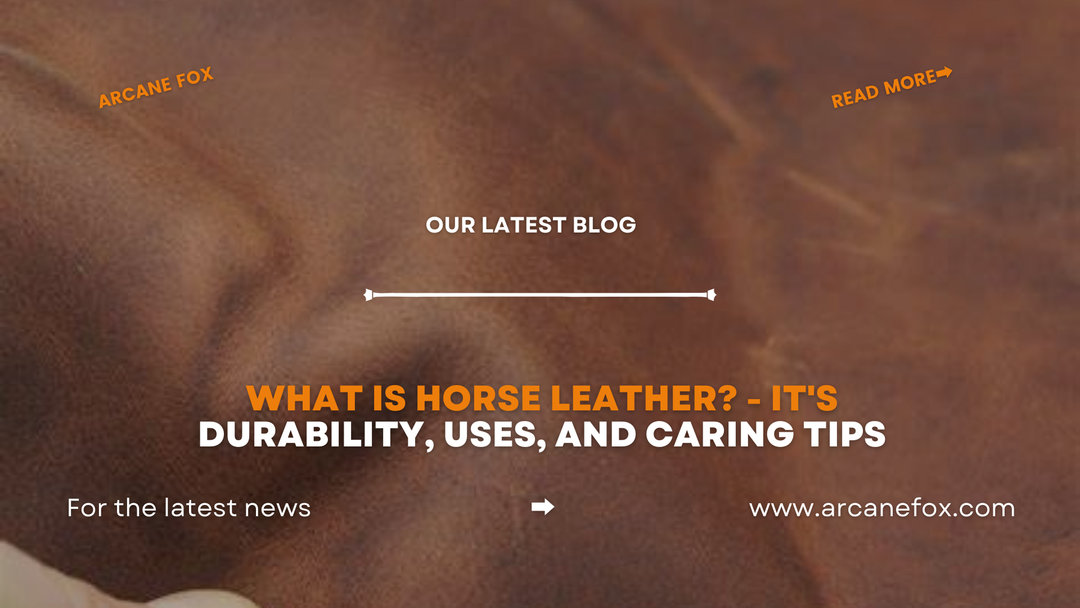What is Horse Leather? - It's Durability, Uses, and Caring Tips

What is Horse Leather? - It's Durability, Uses, and Caring Tips
Horse leather, also known as horsehide, is a premium material celebrated for its exceptional durability, unique texture, and timeless appeal. Unlike more commonly known leathers like cowhide leather, horsehide offers a distinct set of characteristics that make it highly sought after in various industries, from fashion to outdoor gear.
This comprehensive guide explores the fascinating world of horse leather, delving into its rich history, the meticulous process of its production, and the numerous applications that showcase its versatility.
In this blog post, we will uncover what sets horsehide apart from other leathers, explore its various types, and provide valuable insights into caring for horse leather products to ensure their longevity. Whether you're a leather enthusiast, a fashion aficionado, or someone interested in durable materials, this guide will provide you with everything you need to know about horse leather. Let's dive in and discover why horsehide remains a preferred choice for premium leather goods.
1. What is Horsehide Leather?

Crafting horsehide leather involves using the skin of horses, which offers a unique blend of durability and distinctive texture. Historically, people used horsehide not only for transportation but also in combat, making armor, shields, and other protective gear due to its sturdy properties. Today, artisans prize horsehide leather for crafting premium leather jackets, boots, and gloves, celebrated for its strength and unique grain patterns.
People recognize horsehide leather for its high quality and longevity. It is tougher and more abrasion-resistant than cowhide leather, making it a preferred choice for outdoor gear and protective wear. The distinct texture of horsehide also lends a unique and appealing look to finished products.
Horsehide leather offers numerous benefits, including exceptional strength, durability, and water resistance. It is more resistant to breakage and tears compared to cowhide, goat leather, and lambskin leather, making it ideal for heavy-duty applications. The characteristic grain pattern of horsehide adds to its unique appearance and appeal.
2. Characteristics of Horsehide Leather
Horsehide leather is distinguished by its rough surface and unique grain pattern, which can vary significantly from one hide to another. This leather is known for its toughness and durability, offering resistance to wear, punctures, and water. One of the key features of horsehide leather is its breathability, allowing air to circulate and preventing the buildup of sweat. This makes it more comfortable to wear in hot weather compared to other types of leather, which can become uncomfortably warm. The high-quality nature of horsehide leather makes it an ideal choice for a variety of outdoor and heavy-duty applications.
3. Types of Horse Leather
Horse leather comes in various types, each offering unique qualities and characteristics. The most common types include:
3.1 Full-Grain Horsehide:
This type is made from the outermost layer of the hide, preserving the natural grain. Full-grain horsehide is highly durable and retains the natural markings of the animal, adding to its aesthetic appeal.
3.2 Shell Cordovan:
Shell Cordovan, renowned for its smooth texture and glossy finish, comes from the fibrous flat muscle beneath the hide on the rump of the horse. Manufacturers highly prize this specific type of horse leather for its unique luster and strength, often using it in luxury footwear and accessories.
3.3 Vegetable-Tanned Horsehide:
Tanners use natural plant extracts to tan this type of horsehide, enhancing its durability and giving it a rich, natural color. People often choose it for its environmental benefits and traditional appeal.
3.4 Chrome-Tanned Horsehide:
Chrome tanning is a faster process that uses chemicals to produce a softer, more flexible leather. This type of horsehide is often used for garments and accessories that require a softer feel.
Each type of horse leather offers distinct benefits, making it suitable for a wide range of uses, from high-end fashion to durable workwear.
4. How is Horse Leather Made?

The process starts with selecting high-quality horsehides. Inspectors carefully check these hides for defects and then thoroughly clean them to remove any dirt, hair, or flesh.
Tanning plays a critical role in treating the hide to preserve it and make it durable. Tanners use two main methods for tanning horse leather: vegetable tanning and chrome tanning. Vegetable tanning utilizes natural tannins from plants, resulting in firmer, eco-friendly leather with rich colors. In contrast, chrome tanning employs chromium salts, producing softer and more pliable leather.
After tanning, tanners dye the leather to achieve the desired color, using either natural or synthetic dyes, depending on the type of finish required. The leather may also undergo additional finishing processes, such as buffing or embossing, to enhance its texture and appearance.
Once dyed, tanners carefully dry the leather to remove any remaining moisture. They then condition it with oils or waxes to keep it supple and enhance its water resistance.
Inspectors conduct a final quality and consistency check on the finished leather. They then cut it into various sizes and shapes, ready to craft into products like leather jackets, bags, and shoes.
The meticulous process of making horse leather ensures that the final product is not only aesthetically pleasing but also durable and long-lasting. This attention to detail is what makes horsehide a preferred choice for premium leather goods.
5. Uses of Horsehide Leather

5.1 Historical Uses:
- Military equipment
- Equestrian gear
5.2 Modern Applications:
5.3 Practical Benefits:
- Resistance to wear and tear
- Water resistance
- Breathability
5.4 Versatility:
- Ideal for outdoor activities
- Preferred for both style and functionality
The unique texture, durability, and adaptability of horsehide leather have made it a popular choice for both consumers and manufacturers in various industries.
6. Pros and Cons of Horse Leather
6.1 Pros
- Durability: Horsehide leather is exceptionally durable and can withstand heavy use, making it ideal for long-lasting products.
- Unique Texture: The distinct grain pattern of horsehide leather adds a unique and attractive look to finished goods.
- Water Resistance: Horsehide leather is naturally water-resistant, which makes it suitable for outdoor wear and accessories.
- Breathability: This leather is breathable, preventing sweat buildup and ensuring comfort, especially in warmer climates.
- Strength: Horsehide leather is tougher than many other types of leather, providing excellent protection and resilience.
6.2 Cons
- Stiffness: Initially, horsehide leather can be stiffer than other leathers, requiring a break-in period to become more pliable.
- Cost: Due to its quality and durability, horsehide leather products can be more expensive than those made from other leathers.
- Limited Availability: Horsehide leather is less commonly available compared to cowhide, which can limit options and increase costs.
- Heavy Weight: Horsehide leather tends to be heavier, which might not be suitable for all applications, particularly in lightweight clothing or accessories.
- Maintenance: It may require specific care and conditioning to maintain its appearance and durability over time.
Overall, horsehide leather offers numerous benefits, particularly in terms of durability and unique aesthetics, but it also comes with some considerations such as cost and maintenance requirements.
7. Caring for Horsehide Leather

- Frequent Cleaning: Regularly clean horsehide leather to prevent discoloration and cracking. Use a mild soap and water solution to gently wipe down the leather.
- Conditioning: After cleaning, apply a leather conditioner to keep the material supple and moisturized. This helps maintain its appearance and durability.
- Avoid Extreme Temperatures: Protect horsehide leather from extreme temperatures, which can cause cracking and damage. Store leather products in a cool, dry place.
- Address Discoloration and Cracks Promptly: If the leather becomes discolored or develops cracks, address the issue immediately. Use a horsehide leather cleaner or conditioner, or consult a professional leather care specialist.
- Proper Drying: If a leather jacket gets wet, dry it properly to avoid damage. Avoid exposing it to excessive water and ensure it dries at room temperature, away from direct heat sources.
- Repairing Leather Jackets: For minor repairs, use a leather repair kit to fix or sew the damaged sections. For more significant issues, take the jacket to a professional leather repair specialist.
- Avoid Ironing: Do not iron leather jackets, as the heat can damage the material. Instead, use a steamer or hang the jacket in a bathroom with steam to remove wrinkles safely.
Regular maintenance is crucial for preserving the lifespan of horsehide leather items, ensuring they remain in good condition and look their best.
8. Closing Thoughts
Horsehide leather stands out for its unique combination of durability, distinctive texture, and aesthetic appeal. Whether you're looking for a material that can withstand heavy use or seeking something with a rich, natural look, horsehide leather offers a compelling choice. Its use in a variety of products, from jackets and boots to high-end accessories, underscores its versatility and timeless appeal.
While horsehide leather may come with a higher price tag, its long-lasting nature and unique qualities make it a worthwhile investment. With proper care and maintenance, horsehide leather products can offer both functionality and style for years to come.
In summary, whether you're a fashion enthusiast or simply in need of durable gear, horsehide leather provides an excellent option. Its blend of strength, beauty, and historical significance continues to make it a sought-after material in various industries. As you explore the world of leather, consider the benefits and unique attributes that horsehide has to offer.
Related Posts:
Leather 101 - The Ultimate Guide to Different Types of Leather
What is Cowhide Leather? Origins, Types, and Maintenance
What is Goatskin Leather? Different Types of Goatskin, Quality, Durability and More
What is Sheepskin Leather? Everything You Need To Know
What is Lambskin Leather? The Ultimate Guide on Quality, Durability and More
What is Exotic Leather? Origins, Types, Care, and more
What is Calfskin Leather? It's Quality & Durability Against Other Leather!
What is Buffalo Leather? - It’s Uses, Care, and Comparison with Other Leather





